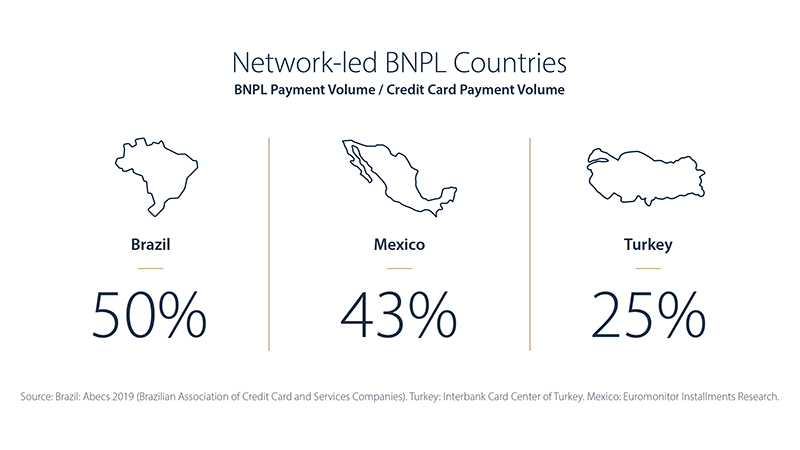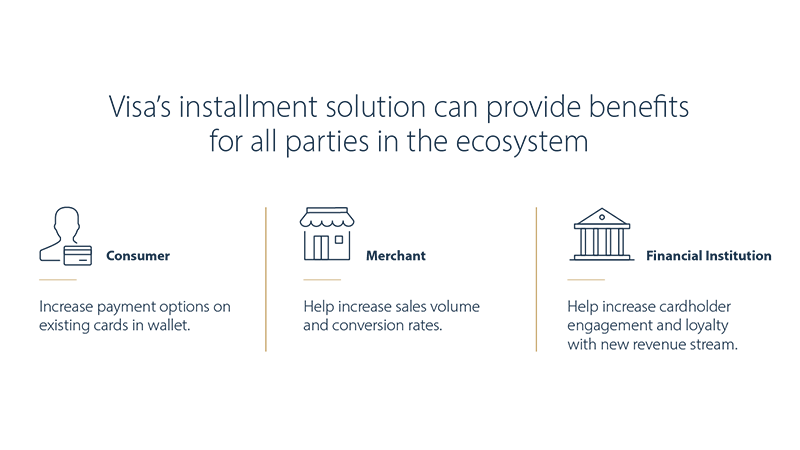

As mobile and ecommerce outpace in-store shopping, demand for “buy now, pay later” options rise for merchants and consumers.
The popularity of “buy now, pay later,” or BNPL (also known as installments payments, installment loans, and any point of sale lending solution), has accelerated and is showing no signs of slowing. In recent years, BNPL volume has been growing approximately 20 percent year-over-year,¹ with a market opportunity of $1.7 trillion.¹ Global BNPL volume among the top fintechs jumped from $46 billion in 2019, to $75 billion in 2020.² In Canada, where consumers are seeking more flexible payment options, there has been 30 percent growth in BNPL over the last year.³ Though the rise of installments is evident, BNPL is only a fraction of total industry’s payment volume, estimated to be approximately $100 billion to $150 billion.
The industry’s response has been everything from the rise of new upstarts to deep partnerships and a convergence between traditional issuers and fintechs, as well as some consolidation as the space evolves. Since 2017, Visa has enabled the leading BNPL fintechs to issue digital credentials or virtual cards, so consumers can seamlessly use installments at checkout. Some of the leading BNPL fintechs working with Visa include: Afterpay, ChargeAfter, Klarna, Paidy, Sezzle, SplitIt, and Zip (formerly Quadpay).
In 2019, Visa rolled out a Visa Installments pilot, which is now becoming available to eligible consumers and businesses in Australia, Canada, Malaysia, and the U.S., with plans to expand to other markets. Visa has collaborations with leading issuers and acquirers such as CIBC, Desjardins, Moneris and Scotiabank to bring installments to participating merchants and eligible credit cardholders in Canada. The company also announced the expansion of Visa Installments in Australia in partnership with ANZ, one the country’s largest financial institutions, and merchant payment provider Quest. In October 2021, Klarna signed a global brand deal with Visa to accelerate expansion and scale in several markets. Visa currently offers a portfolio of solutions that captures all addressable BNPL flows on Visa rails, including Visa Installments Solution, standalone credentials and a range of other bespoke technologies.
Historically, installments as a consumer payment solution have been widely adopted in markets around the world such as Brazil, Mexico and Turkey. The programs in these countries, while different in the mechanics of how they operate, are all card-based and underwritten by a traditional financial institution. In Brazil, installment loans represent approximately 50 percent⁴ of all credit card payment volume.

Installments Experience a Second Wind
So why have BNPL fintechs taken off in the last five to 10 years? In truth, there is a confluence of factors, but it centers on the rise of digital technology.
You can’t separate the rise of BNPL from the rise of ecommerce. The digital orientation of the commerce experience makes it not only possible, but almost seamless, to integrate installments.
Over the last two years, accelerated by the pandemic, ecommerce in the U.S. has grown to now represent 14 percent of all retail sales, a jump from 9.9 percent in 2018.⁵ Across Visa’s network, cross border card-not-present volume growth, excluding travel, continued to strengthen, up 26 percent in Fiscal Q1 2022 (year over year) and 50 percent above 2019.⁶
Not surprisingly, 18 percent of U.S. adults surveyed used BNPL for the first time since the pandemic,⁷ showing how the market conditions accelerated adoption of installments – just as they did almost every other form of digital payment.
Even though there is an acceleration of BNPL due to the broader shift to ecommerce, it is early days and there are larger market trends driving its longer-term growth.
The rapidly evolving BNPL landscape
As with a host of services, from ride sharing to vacation rentals, the digital age has transformed the BNPL process. Consumers no longer have to complete tedious forms in-person at a store or bank and there is no longer a waiting period to be approved for a BNPL loan.
The rise of fintechs and their focus on “design-thinking” is the second reason for the growth of BNPL. The BNPL user experience offered by a new breed of fintechs is engaging and easy for the consumer. This design-led approach is something traditional financial institutions are embracing. Now, with solutions like Visa Installments, an offer can be presented and accepted on an eligible consumers’ approved credit line via credentials already in their pockets or wallets.
The ease of use and flexibility of installments is proving to be a win-win for consumers and sellers. For consumers, installments offer transparency, control and in many cases, interest-free offers.
BNPL has grown more popular with sellers because they view the program as an effective marketing capability that offers high return on investment. Because of the measurable sales lift associated with BNPL, many sellers are willing to finance the installment offer, providing zero percent interest to the customer. So, if a seller bears the interest costs of financing a $1,000 sofa of several percent, that provides a considerably higher return of investment than offering a five percent discount on the same item. It’s a no-brainer for sellers to front the cost of financing an installment loan when conversion rates can be well into double digits.
A survey by research firm Ascent shows that electronics, clothing, and furniture and appliances are the three most popular categories for BNPL loans.⁸ This data suggests consumers are gravitating toward BNPL to fund discretionary purchases beyond day-to-day essentials.

Research suggests that BNPL is most popular among consumers aged 18-44, with uptake in this segment increasing to more than 60 percent.⁹ Interestingly, the most significant jump in usage was among Gen Y consumers (aged 18-24), with BNPL usage jumping from 38 percent to 61 percent from July 2020 to March 2021.⁹
It is a myth however that BNPL is a millennial product, popular only with younger consumers. Forty-one percent of consumers aged 54 and older had used a BNPL product by March 2021, almost double the number from the previous year.⁹ In the next few years as different BNPL options emerge through fintechs and traditional banks, more people of different ages will use them.
Different approaches to paying over time
The myriad of different credit models – from traditional revolving credit to new BNPL options – co-exist with one another. In North America, many pureplay installment loan options are driven by fintechs like Afterpay, Klarna, PayPal, Sezzle, and Zip. In most cases, these fintechs work directly with sellers to offer a point-of-purchase solution to consumers.
Other BNPL solutions in North America include seller-led options, like Amazon’s monthly payment program, or card-based solutions (typically post-purchase) issued by a number of U.S. financial institutions. Outside the U.S., there are other BNPL models where financial institutions and networks like Visa are more central to the process. In general, more issuers are coming on board to offer installments during pre- and post-purchase using Visa Installments. Canada is leading the way in North America, and the solution is quickly growing in other markets.
The programs evolved from check-based solutions, whereby the consumer would provide the seller with a series of dated checks that could be deposited over a period of time. Evolving from checks to revolving credit cards made a lot of sense for sellers who offloaded the risk and for issuers who welcomed the additional balances.
API network solutions benefit all stakeholders

A wide range of BNPL solutions is expected to co-exist in North America and elsewhere. Sellers will offer a wide range of installment offers to consumers – ranging from a network solution that might be a six-month repayment plan, or a longer-term loan offered through a fintech, for example. From our perspective, it’s not an either/or – it’s both.
One of the main advantages of a network solution like Visa Installments is the fact that there is no learning curve for consumers and very little for sellers to do in terms of integration.
From the seller perspective, there is the added bonus that the transaction will be successfully processed, as all the approvals and financing is managed by the issuer and acquirer. For issuers, they benefit from maintaining and enhancing their customer relationships.
Importantly, installments will just become a feature for consumers on their existing lines of credit without them needing to do anything further.
BNPL is coming of age
Installments, while not a new phenomenon, is coming of age with the rise of connected devices and the growing popularity of digital commerce. What we’re experiencing today is BNPL 1.0 where fintechs are cutting individual deals merchant by merchant. Eventually, the business model will evolve to BNPL 2.0, where fintech partners will issue Visa credentials so they overcome the challenge of scaling acceptance globally to have immediate access to millions of merchants.
It’s rare in our business to find a solution that can deliver upsides for every party – issuers, acquirers, sellers, and consumers. BNPL can be likened to a new tributary flowing into a river. It isn’t taking anything away - it’s all additive and that is great news for those charged with increasing and improving the flow of commerce.
Canada's Big BNPL Push
Unlike places like Brazil and Turkey, installments in Canada does not currently represent a big percentage of overall payment volume. Financial institutions, merchants and networks like Visa are keen to be part of what is estimated to be a $50 billion opportunity³ in Canada.
According to Brian Weiner, Vice President and Head of Product and Digital, Visa Canada, the fact that BNPL grew 30 percent in 2020 demonstrates consumer appetite for new solutions, including a bank-led, network solution.
“We’ve been watching this trend grow for years, and we’ve developed a solution that is tailor-made for Canadian consumers and merchants,” said Weiner.
The solution in question is one developed by Visa that uses open APIs that can be easily integrated by issuers, acquirers and sellers into their payment systems. Canada is one of the first markets for Visa’s network solution, with other North American locations to come.
In June 2021, Scotiabank rolled out SelectPay™ leveraging Visa Installments. Eligible Canadian Scotiabank Visa credit cardholders can choose to take advantage of Scotiabank’s new SelectPay™ payment installment plans, where they can choose to convert qualifying credit card purchases they’ve already made on their Scotiabank Visa card into fixed monthly installment payments in this post-purchase solution.
Desjardins launched Visa Installments for its eligible cardholders in July 2021, enabling them to opt for more flexible payment options on qualifying purchases during checkout at participating merchants.
This year, CIBC is planning to provide the option for eligible Canadian CIBC cardholders to utilize Visa Installments on qualifying purchases during their shopping experience at participating merchants. Cardholders can then pay for the purchase in installments as part of their monthly credit card payments.
All brand names, logos and/or trademarks are the property of their respective owners, are used for identification purposes only, and do not necessarily imply product endorsement or affiliation with Visa.
- Euromonitor Consulting: Installment Payment Opportunities, April 2020
- Visa volume analysis in aggregate as reported in financial and annual reports by top fintech companies
- Euromonitor Consulting Data Compilation for Visa Inc. ($CDN)
- ABECS Brazil Business Association of Credit Companies, 2019
- “Global e-commerce jumps to $26.7 trillion, fueled by COVID-19,” UN News, 2021, https://news.un.org/en/story/2021/05/1091182
- Visa Q1 2022 earnings, January 2022, https://s1.q4cdn.com/050606653/files/doc_financials/2022/q1/CORRECTED-TRANSCRIPT_-Visa,-Inc.(V-US),-Q1-2022-Earnings-Call,-27-January-2022-5_00-PM-ET.pdf
- Ascent Survey, distributed via Pollfish to 2,000 American adults ages 18 and over in July 2020 and in March 2021. Percentage of respondents who have used a buy now, pay later service increased by 18 percent from 38 percent in July 2020 to 56 percent in March 2021 showing increased usage in all age bands with particularly large growth in younger segments 18-34.
- “Buy Now, Pay Later Services Growing Quickly Among U.S. Consumers,” The Ascent (fool.com), 2021, https://www.fool.com/money/research/buy-now-pay-later-statistics/
- “Study: Buy Now Pay Later Services Continue Explosive Growth,” The Ascent, 2021, https://www.fool.com/money/research/buy-now-pay-later-statistics